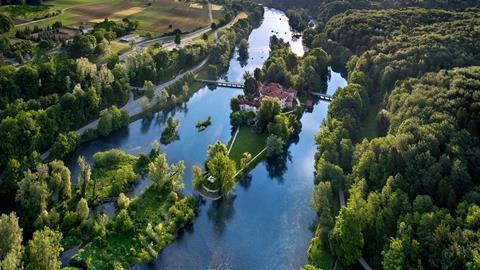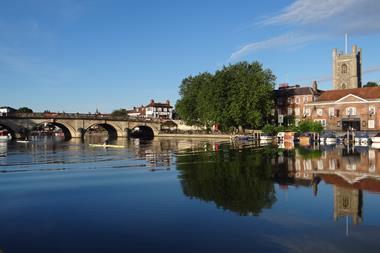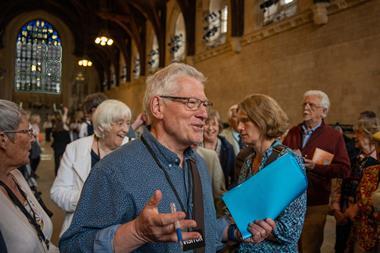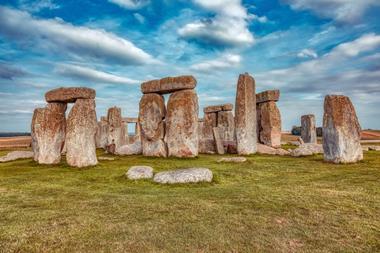A look at Slovenia’s alternative destinations to uncover lesser-known gems from a wine not found anywhere else to a Rapunzel-worthy castle.
Over the past few years, Slovenia has become a sweetheart destination for groups. Most parties fly into either Zagreb or Ljubljana and make a beeline for Lake Bled and/or the country’s southwest coast.
Yet, Slovenia’s other compass points have just as much, if not even more, to offer. In the country’s lesser-trodden corners, you’ll discover everything from rare wines to the monsters that scare off winter.
Dolenjska and the Cviček experience
Make the hour’s drive southwest from Ljubljana, and you’ll reach Dolenjska, a region that’s characterised by big dipper hills clad in grapevines, and the Krka river.
Dolenjska is Cviček country; home to a wine that can’t be found anywhere else in the world. The history, culture, tradition and viticulture entwined with this wine is rich and the best place for groups to find out all about it is at Matjaž’s Homestead.
Set up in the hills near the town of Otočec, where the birds sing and bees buzz so loudly you’d think they had microphones, Matjaž’s Homestead incorporates a 150-year-old country house that has been sympathetically restored, a multimedia presentation and tasting room, and a cluster of thatched roofed, wooden beamed vineyard cottages, which were once used as stables, digs and food stores for local vineyard owners and have now been converted in guest accommodation.
Groups can stay at the wooden vineyard cottages on the Matjaz Homestead which also incorporates a 150-year-old country house that has been sympathetically restored.
Wine barrel hot tub anyone? Guests at the homestead can watch the sunset across the vineyards of Dolenjska, glass in hand...bliss.
Groups of 40 at a time can take guided tours of the country house to see how locals lived in the mid-19th century and take in the multimedia presentation on Cviček, before enjoying a wine-tasting experience and/or traditional Slovenian meal served by former Slovenian Wine Queen Ana Pavlin.
The vineyard cottages at Matjaž’s Homestead can sleep up to 14 between them. However, they’re part of a collective of 40 more neighbouring vineyard cottages that groups can split up to stay in.
The extra logistical effort of splitting up is worth it. Watching a yolky sunset fall across the vineyards of Dolenjska from the soup-warm waters of a wine barrel hot tub or watching the stars wink in the light pollution-free sky as you swing in a hammock on the verandah of a vineyard cottage is something that’s not fast forgotten.
Choosing which vineyard to visit
If your group is a pack of oenophiles, you can springboard from Matjaž’s Homestead to a number of satellite vineyards that all offer group tours and tastings for between 40 and 100 people, depending on which one you choose.
You might think that if you’ve seen one vineyard you’ve seen them all, but in Dolenjska they’re as different to each other as salt and sugar.
At Repnica Najger, the wine cellars are burrow-like. Pickaxed out of subterranean sandstone left behind by the ancient Pannonian Sea, the caves were originally used as vegetable stores. Now their terracotta-coloured walls are lined with bottles of Pinto Gris, Traminer, Yellow Muscat and more. Owner, Alijoska Najger-Runtas, will tell your group all about the cellar and vineyard’s history over several generous samples of wine and plates of spongy potato bread, tangy cheese and smoky prust – all homemade.
At Kerin Winery, meanwhile, your group can take over the pergola-shaded terrace next to the vineyard and watch the butterflies flit in and out of the vines as owner Lojze explains how they make their specialty – white blaufränkisch wine.
Depending on availability, you might be able to try his family recipe ričet – an unctuous barley soup – during or after your tasting.
The vine belt of ideal locations includes Slovenian wine-growing regions with an ideal climate and soil combination. No fewer than 52 vine varieties thrive in Slovenia.
This Rapunzel-worthy 13th-century castle sits on its own island in the middle of the Krka River. Now a popular wedding venue, it’s used to hosting groups.
Finally, there’s Colnar. If NASA opened a winery, it would look a lot like this one. Group tours take in areas like the acidity lab and offer an insight into how the winery is striving to become carbon negative.
If you’re not quite as wine-minded, a coffee at Otočec Castle should be on the cards before you leave Dolenjska.
This Rapunzel-worthy 13th century castle sits on its own island in the middle of the Krka River. Now a popular wedding venue, it’s used to hosting groups.
Alternatively, continue as you started with a visit to Šmarjeta. This dinky town is home to a wine fountain between April and September, where you can sample four different types of locally made Cviček wine for nine euros (and you get to keep the wine glass as a souvenir).
The Dvorec Gregorčič mansion restaurant by Šmarjeta’s main square also comes highly recommended and is used to welcoming groups. The menu changes with the seasons, but the chef is known for adding twists to classic Slovenian dishes.
Retracing the footsteps of monks in Slovenske Konjice
From Dolenjska, a 90-minute drive northeast will get you to Žiče in Slovenske Konjice and the bowl-like valley of Saint John the Baptist, which is home to the toothy ruins of the first ever chapterhouse to be established in Central Europe.
A group tour will take you around the upper house of the monastery where you can learn about the silent lives of the monks that once lived there and walk the energy circle.
The Žiče monastery is the first ever chapterhouse to be established in Central Europe. Groups can learn about the silent lives of the monks that once lived there and walk the energy circle.
Every February, the residents of Ptuj, the oldest recorded city in Slovenia, don 50kg costumes and parade through the streets as monsters to chase away winter and induce spring.
If you have time, your group will thank you for booking into Spargus – the restaurant that now occupies the building that was once the lower house of the monastery.
The tasting menu is full of Michelin-worthy foams, gels, emulsions, reductions, tuiles and quenelles and comes in at just 55 euros for five courses.
If you’re celebrating, start your meal with a glass of Zlati Grič sparkling, which is now stored in the wine cellars of the monastery, and add a bottle of Sanctum Carthusian Red to your order – the grapes for this wine are harvested from the Žička gorca vineyard where Carthusian monks cultivated the blaufrankisch grape variety centuries ago.
Ptuj and the monsters that chase away winter
A further 40-minute drive east from Žiče will get your group to Ptuj, the oldest recorded city in Slovenia.
This red-roofed, lakeside city will easily eat into a couple of days of your schedule. A walking tour, a guided tour of the city’s hilltop 12th century castle, and a visit to the Kurant Museum are all must-dos for groups.
The latter offers an insight into Ptuj’s Kurants – the monsters that chase away winter. Every February, locals don 50-kilogram 1,000 euro Kurant costumes and parade through the streets to induce spring.
Wine lovers can also visit the Ptujska Klet winery, which is also home to the oldest wine cellar in Slovenia. Groups can take guided tours here, to find out about its 900-year history and to see a bottle of Slovenia’s oldest wine – the 1917 Golden Vine wine. Tastings that involve a multimedia presentation are also an option at Ptujska Klet.
Maribor, Slovenia’s second city…
After Ptuj, it’s a quick 40-minute hop north to Maribor, Slovenia’s second-largest city. If you only do one thing here, make it a visit to the Old Vine House – home of the world’s oldest producing vine and a museum at which you can learn about everything from Slovenia’s wine queens to Slovenia’s Knights of Wine.
Then from Maribor, it’s a 90-minute drive back to Ljubljana, where you can hop back on the more beaten group path to Lake Bled.
The Slovenian Tuscany
If you still have time in your schedule, you should detour to Brda, located just above the group-favourite town of Piran. Speared with cypress trees and cornrowed by vineyards, this region is known as the Slovenian Tuscany.
There’s a vineyard on every corner of this patch of Slovenia, including the eye-widening Jakončič Winery, where the tasting room features a £35,000 bottle of wine and the cellars are home to alien-looking egg-shaped barrels. Only 12 people can tour here at a time, but larger parties can split up and take it in turns to visit the winery and one or more of its neighbouring sights.
The Sabotin Peace Park was once at the heart of a 90-kilometre World War One battlefront between Italy and the former Austro-Hungarian Empire.
The cellars of the Jakončič Winery are home to alien-looking egg-shaped barrels. Small group tours are available and check out the tasting room while you're there, it features a £35,000 bottle of wine.
Options include the corkscrew-shaped Gonjače Lookout tower, where visitors who scale the 144 stairs are rewarded with grandstand views of the wavy Brda countryside.
Or there’s Sabotin Peace Park. Set at the top of the 609-metre Sabotin Hill, this modern peace park was once at the heart of a 90-kilometre World War One battlefront between Italy and the former Austro-Hungarian Empire. Groups can take tours of the trenches and tunnels that were painstakingly chiselled out of the mountainsides by soldiers over the course of the conflict and learn more about the bloody battles that took place along the line.
Jakončič Winery does offer food pairings, but if you want to all sit down together, the café at the top of Sabotin Hill cooks up big batches of classic Slovenian dishes like Jota – a hearty sauerkraut and bean stew that’s served with a truncheon-sized sausage – and the open-air seating area is an appropriate place to reflect after a thought-provoking tour of the trenches.
For more information and Slovenia inspiration, visit www.slovenia.info/en













